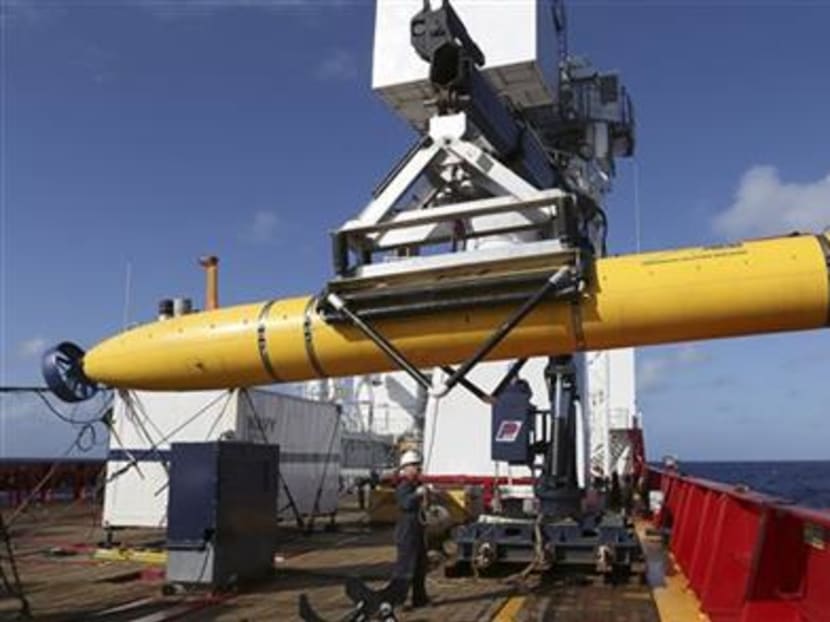Australia flags deeper search for MH370
CANBERRA — The hunt for the missing Malaysia Airlines jet will likely soon deploy more powerful sonar equipment that can delve deeper as the current search of the most likely crash site in the Indian Ocean has failed to yield any clues, Australia’s defence minister said today (April 23).

In this April 17, 2014 photo provided by the Australian Defence Force the Phoenix International Autonomous Underwater Vehicle (AUV) Artemis is craned over the side of Australian Defence Vessel Ocean Shield before launching the vehicle into the southern Indian Ocean in the search of the missing Malaysia Airlines Flight 370. Photo: AP
CANBERRA — The hunt for the missing Malaysia Airlines jet will likely soon deploy more powerful sonar equipment that can delve deeper as the current search of the most likely crash site in the Indian Ocean has failed to yield any clues, Australia’s defence minister said today (April 23).
The search coordination centre said today a robotic submarine, the United States Navy’s Bluefin-21, had so far covered more than 80 per cent of the 310 sq km seabed search zone off the Australian west coast, creating a three-dimensional sonar map of the ocean floor. Nothing of interest had been found.
The 4.5km deep search area is a circle 20km wide around an area where sonar equipment picked up a signal on April 8 consistent with a plane’s black boxes. The black box beacons’ batteries would by now be dead.
Defence Minister David Johnston said Australia was consulting with Malaysia, China and the United States on the next phase of the search for the plane that went missing March 8, which is likely to be announced next week.
Mr Johnston said more powerful towed side-scan commercial sonar equipment would probably be deployed, similar to the remote-controlled subs that found RMS Titanic 3,800m under the Atlantic Ocean in 1985 and the Australian WWII wreck HMAS Sydney in the Indian Ocean off the Australian coast, north of the current search area, in 2008.
“The next phase, I think, is that we step up with potentially a more powerful, more capable side-scan sonar to do deeper water,” Mr Johnston told The Associated Press.
While the Bluefin had less than one-fifth of the seabed search area to complete, Mr Johnston estimated that task would take another two weeks.
“We want to be very thorough,” he said.
The Bluefin’s first 16-hour sea floor mission last week was aborted because the water depth exceeded its 4.5km safety limit. Mr Johnston said it was possible that wreckage had been missed in that deep water.
The focus of next phase of the seafloor search whether it will include the initial search area would be decided on by continuing analysis of information including flight data and sound detections of suspected beacons, he said.
“We are currently gathering all of the facts together to mount a further assault on the most likely location, given all the facts,” he said. “But can I say, it is one hell of a vast area.”
“A lot of this seabed has not even been hydrographically surveyed before — some of it has — but we’re flying blind,” he said, adding that the seabed in the vicinity of the search was up to 7km deep.
“The whole thing is extraordinarily complex in one of other most isolated parts of the ocean on the planet in very deep water,” he added.
The air search for debris would likely continue until a new search phase is announced next week, he said.
The search centre said up to 10 planes and 12 ships would join today’s search of an expanse covering 38,000 sq km, centred 1,600km north-west of the city of Perth.
Radar and satellite data show the jet carrying 239 passengers and crew veered far off course on March 8 for unknown reasons during a flight from Kuala Lumpur, Malaysia, to Beijing. Analysis indicates it would have run out of fuel in the remote section of ocean where the search has been focussed. Not one piece of debris has been recovered since the massive multinational hunt began. AP






